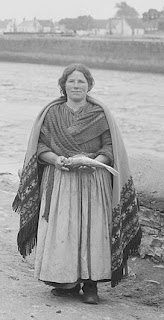The Farmer's Market Today
Did you ever wonder what marketing differences our ancestors had when compared to us today?
Wikipedia has this to say, "According to etymologists, the term 'marketing' first appeared in dictionaries in the sixteenth century where it referred to the process of buying and selling at a market."
Of course, we must remember that in the sixteenth century there weren't any super markets. Farmers would bring their produce to a central location. This might be within a keep, or even without the walls of a keep. The local 'laird' would have his cooks purchase from the first "pickings". This would mean that commoners would then purchase from whatever was left. But more often than not, they would barter.
For instance, a local cheesemaker might barter for eggs, and a bucket of grain. A weaver might barter for cabbage and carrots with a few yards of cloth.
And, of course, there were those who purchased with coin. During the 1500's, however, the commoner had very little coin. Coin was earned, and spent, by those who held titles and lands. The commoner was used to, for the most part, bartering.
Bartering is still alive and well in many places today. I have seen those at our local farmer's market that barter. I've seen someone who needed baskets for their strawberries barter a gallon of fresh strawberries for 3-dozen quart baskets. I've seen someone who bartered fresh, brown eggs for a quart of honey. I've seen greens bartered for squash.
This practice is, perhaps, one considered to be a favorite amongst the local marketers. Of course, then the public arrives, and the cash flows.
But of one who needed a new vest? Or a dress? Well, there were few dressmakers or tailor's in rural society. However, they were found in the larger cities. But you wouldn't see a finished garment hanging upon a rack! No. Indeed, it was more likely that you would drop by the local dressmaker's and make an appointment to come back in for a measuring. At that time, you would be taken into an area where you would undressed down to your chemise, and then a tape measure would be produced and your measurements would then be recorded. After you were measured, the dressmaker would sit you before a portfolio, from which you would then pick out a pattern you liked. Fabrics would then be produced for you to choose from. And if a suitable fabric was not in the shop, you would have to either get the dressmaker to choose a fabric for you, or pay extra to have what you wanted shipped in. The process of getting a dress could take anywhere from a few weeks, to a matter of months. A similar process was used for the purchase of men's clothing from a tailor.
And what of the country maid who required a new dress? Chances were, that if you were a country maid, your garments would have been handed down and remade to fit you either from an older sibling, or even from your mother. Many a child wore the a dress made from her mother's skirts.
If you were poor, you may have only linen cloth to choose from. This was a coarse material woven on a hand loom. I have made this fabric myself with an old wall loom (it literally leans against a wall when in use). This does not produce the same effect as linen woven on a large loom with a foot shuttle. It, instead, produced a wider weave, that was used for heavier threads. Often, if you purchased coarse linen, you would also purchase, or make, yarn to knit a Galway shawl.
Galway Shawl
This was a type of shawl that crisscrossed over the bosom, and was tied behind the back. It was a way of keeping warm. In the winter a cape could be worn over it. And in the summer, the sleeves of the linen dress could be rolled up. A chemise (an under slip) provided modesty so that the legs would not be seen from under the linen skirt. And an apron wore over the skirt would also provide modesty. A woman added color to her clothing using what Mother Nature provided her with. Beets, nut shells, nuts, bark, etc. So that, even if you were not wealthy, you could still get a new "shift" now and then.
And, as I said, children wore hand-me-downs, or the mother's old shift was used to make one or two smaller ones for the children.
Housewares were often bartered for as well. A wooden bucket for a boiling pan or fry pan. A pony for a couple of shoats (baby pigs). Chickens for geese. And so forth.
How very simple we have it today. We have our choice of where we want to shop. And we purchase according to our budgets.
Do you share any of the trades crafts your ancestors might have had? And if so, what are those crafts? Could you make it in a society where you might have to make everything yourself? Please share your comments below! We love hearing from you!











No comments:
Post a Comment